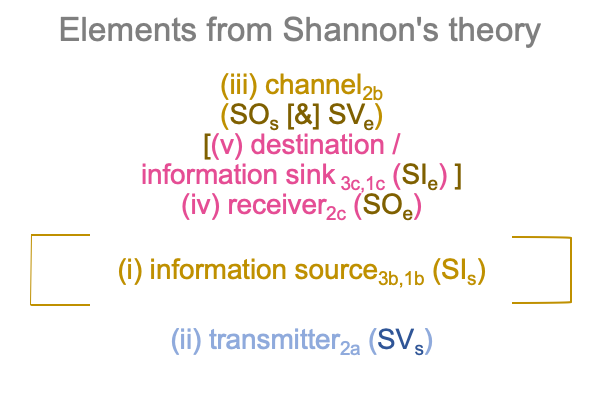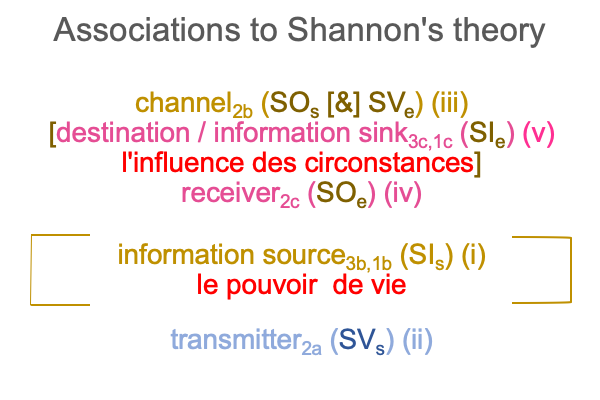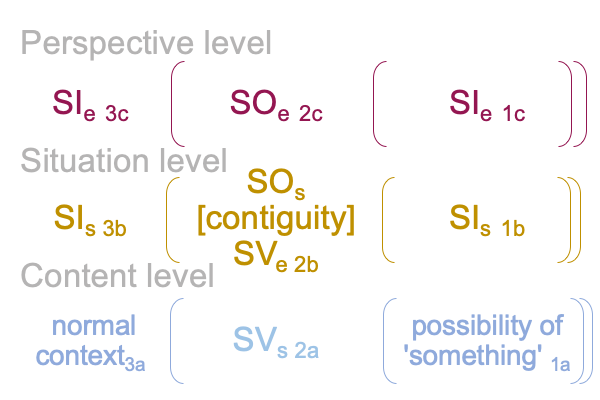0364 According to Shannon’s information theory, which offers a mathematical model for “information” occurring in human-mediated electro-magnetic transmissions, there are five components to the whole process: (i) an information source, (ii) a transmitter, (iii) a channel, (iv) a receiver and (v) a destination that serves as an information sink.
0365 Can I draw associations to the S&T noumenal overlay?
I suppose so.
0366 The specifying sign-interpretant3b,1b (SIs) is like an information source (i) and the specifying sign-vehicle2a (SVs) associates to the transmission (ii) of something2a that stands for information2b (SOs). Maybe, I can say that the SVs is like a transmitter (ii) and SOs is like that transmission entering the proper channel (iii).
The SOs is contiguous with SVe, so a transmission in the proper channel2b (iii) constitutes an exemplar sign-vehicle2b(SVe) that stands for a perspective-level actuality2c (SOe) (iv), according a perspective-level normal-context3c and potential1c (SIe) (v). So, the SOe may be labeled as a receiver (iv) and the exemplar sign-interpretant3c,1c (SIe) associates to the information sink or destination (v).
0367 Here is a picture.

0368 Of course, my associations are both evocative and fallible.
Here are three implications (F, G, H).
0369 First (F), Shannon’s theory of communication regards biosemiotic sign-interpretants as sources (i) and receivers(iv). These are precisely the elements in the S&T noumenal overlay that need to be explained. Shannon’s theory places them in black boxes and treats them as givens.
What does that imply?
From the point of view of biosemiotics, I wonder, “What is Shannon’s theory actually modeling?”
0370 After all, if I go to the start of the chapter, the two crucial aspects involved in biological change, as characterized by the premoderns, correspond to sign-interpretants.

0371 Shannon’s theory of communication takes these two primordial aspects for granted, in order to concentrate on another question.
What is the channel’s capacity to carry information?
0372 What is so important about the channel2b (iii)?
Hmmm. I see that the channel2b corresponds to “information2b” and to SOs[and]SVe.
What is that about?
Is [and] the same as [contiguity]?
Is this topic about to get fuzzy?
0370 Second (G), Shannon’s theory of communication, as depicted above, is consistent with a biosemiotic approach in regards to the sources of phenomena for communication: transmitter (SVs) (ii), channel (SOs [and] SVe) (iii) and receiver (SOe) (iv).
Okay, so everything’s fine.
0371 Does that mean that Shannon’s theory of communication somehow is relevant to the hypothetical scenario where the... um… vehicle of a beta-linked polysaccharide2a (SVs) is “transmitted” then “received” as the object of glucose molecules ready to power a wood-eating insect’s metabolism (SOe)?
In this case, does the term, “information2b“, correspond to “the ability of a gut bacteria’s dual-modular claw and jaw apparatus to cleave the terminal glucose of a beta-linked polysaccharide”?
It makes me wonder about the meaning, the presence and the message underlying the word, “information2b“.
There seems be a lot going in within the situation-level actuality2b, which is where the SOs transits into the SVe.
0372 Third (H), Shannon’s theory of communication, expressed as an application of the S&T noumenal overlay,presents a simplification that drags the inquirer to that confounding channel2b.
After all, the channel (iii) goes with phenomena.
In human electronic communication technology, the channel2b can carry only so much information2b. Noise is the loss of information2b. Is “noise” information that can no longer be properly received? Or is “noise” some lacking that makes information no longer salient?
Questions like these, as problematic as they are, seem well-cogitated compared to ones that arise when Shannon’s theory of communication is transferred from the dyadic S&T noumenal overlay to a three-level interscope containing the specifying and exemplar sign-relations.

